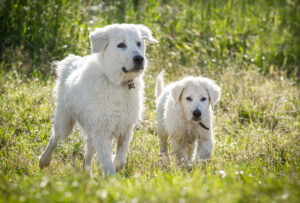If you’re a dog owner, then you must have, at one point or another, witnessed your canine buddy acting out in its sleep. And it is only normal to wonder what the contents of a pooch’s dreams are and whether dogs, like humans, can have bad dreams. So, can dogs have bad dreams?
Dogs are capable of having bad dreams. However, because most dogs are incapable of developing memories on their own, a dog’s nightmares are largely influenced by unpleasant experiences that have taken place during the day.
That said, having to deal with a dog that experiences bad dreams on a regular basis can be an unpleasant and exhausting experience, and this is why we’ve outlined practical steps you can take to reduce your pooch’s bad dreams.
Additionally, it is useful to have knowledge of how to proceed when your dog has a bad dream, and this article also contains instructions on what to do when your dog is having a nightmare. Before we go into all this, however, let’s examine the process of dreaming in dogs and why pooches can have nightmares.
Can Dogs Have Bad Dreams?

Yes, just like humans, dogs are capable of experiencing bad dreams.
To fully understand why dogs can have bad dreams, we first need to understand the canine sleep cycle, and what happens when pooches have dreams – either good or bad.
Generally, the canine sleep cycle is divided into two stages; the Short Wave Sleep (SWS) stage and the Rapid Eye Movement (REM) stage.
The SWS stage occurs when dogs first fall asleep, and this stage is characterized by a slowdown of brain waves. Additionally, during the SWS stage of sleep, a dog’s muscle tone remains active, and such a pooch will wake up with the slightest disturbance.
Subsequently, the dog settles into deeper sleep, also known as the REM stage, which is characterized by the dog’s eyeballs moving rapidly behind closed eyelids.
During the REM stage of sleep, the dog’s muscle tone is more relaxed, and the pooch can sleep soundly without disturbance.
However, the dog’s mind becomes more active during the REM sleep stage, which is when pooches typically have dreams.
What Do Dogs Dream About?
Due to the inability of our canine buddies to communicate with us via human language, it is almost impossible to determine the contents of any pooch’s dreams.
Regardless, several scientific studies and researches have been carried out to try and determine what makes up a dog’s dreams.
It has been postulated that the canine dream experience largely involves dogs, like humans, reliving their daytime experiences. And this typically results in the pooch sleep running, as it attempts to retrieve a ball or chase after a cat.
What Causes Dogs To Have Bad Dreams?
Causes of nightmares vary from dog to dog, but generally, a dog’s bad dreams typically occur as a result of the pooch dreaming about something that would induce anxiety or fear in such a pooch if it were awake.
Common examples of situations that cause fear in dogs, and by extension, bad dreams include:
- Sudden loud noises
- Storms
- Fire
- Encounters with unfamiliar people
- Grooming exercises
Now that we’ve established that dogs can, indeed, have both good and bad dreams, let’s have a look at some observable behaviors that distinguish canine nightmares from pleasant dreams.
How Can I Tell That My Dog Is Having A Bad Dream?

Nightmares typically cause dogs to growl in their sleep while also exhibiting behavior such as whimpering, whining, or barking.
Determining whether or not your canine buddy is having a pleasant dream or a nightmare can initially be tricky due to the similarities in the behavior exhibited by pooches during both situations.
But the more you observe your pooch while it is dreaming, the easier it becomes for you to determine the nature of Fido’s dreams.
That said, some of the signs typically exhibited by dogs when they have a bad dream include:
- Growling
- Twitching paws and eyes
- Barking
- Whimpering
- Whining
- Suddenly jerking awake
What Should I Do When My Dog Is Having A Bad Dream?
In most cases, it is recommended to let a dog sleep out its dream, but you can also try gently rousing the pooch out of its sleep and playing soft music to soothe the dog once it wakes.
Determining Whether Or Not To Wake The Dog
Once most dog owners come across their canine buddies struggling with a bad dream, the initial reaction is usually to try and wake the dog up. However, while the intentions may be good, the outcome of trying to rouse a dog from its sleep may be unsavory.
Waking a dog from its bad dream can cause the pooch in question to become disoriented and lash out at you. And in lashing out, the dog may growl at you or even bite you!
It is advised that you should proceed with extreme caution when attempting to wake a dog from its sleep, and you should only do this if you notice that the pooch in question is sleeping fitfully.
Gently Rouse The Dog
Rather than attempting to violently shake a dreaming dog from its sleep or even move closer to such a pooch, you can try waking such a dog by calling its name in a gentle voice.
This method of rousing a sleeping dog is considerably safer, and it helps minimize the risk of you being on the receiving end of an outburst and getting bitten by the pooch in question.
Note that your dog may not respond to you calling its name on the first attempt, and you may have to call out Fido’s name a few times while gradually increasing the volume to get it to wake up.
Failure of the pooch to respond to you calling out its name, coupled with uncontrollable shaking, may indicate that the dog is suffering a seizure, and in such cases, you should get on the phone with a vet.

Leave The Dog To Sleep
It is often said to ‘let sleeping dogs lie.’ In most cases of dogs dreaming, this is usually the best approach to take.
Most times, canine dreams don’t degenerate past dreams. And if you don’t notice your pooch either shaking or salivating while having a dream, it is generally advisable that you leave the pooch to wake up on its own.
Soothing Your Dog With Cool Music
It is only normal for a dog to feel confused after waking from a bad dream, and in this case, playing soft music for the pooch in question can be very effective in helping the dog calm down.
How Can I Stop My Dog From Having Nightmares?
You can effectively stop your dog from having nightmares by determining and eliminating your pooch’s triggers, training the pup to deal with fear as well as regularly engaging the dog in exercises.
While it may be impossible to completely stop your pooch from having dreams, the good news is that there are certain practical steps you can take to protect your canine buddy from nightmares.
That said, some of the ways by which you can stop your dog from having nightmares include:
Determining Your Dog’s Triggers
Most canine nightmares are triggered by activities taking place during the day. And the first step to take when trying to stop your pooch from having nightmares is to try and determine what these triggers are and subsequently reduce your canine buddy’s exposure to these triggers.
Due to the sheer volume of sounds, smells, and sights that dogs are exposed to on a daily basis, it may be difficult to determine, with certainty, what is causing your pooch to have disturbing dreams.
However, by reflecting on activities that took place during the day, each time your pooch has nightmares, you may be able to determine the cause of your canine buddy’s unsavory dreams and subsequently take steps to minimize the pooch’s exposure to these triggers.
That said, some daytime experiences that can cause dogs to have nightmares include loud noises such as fireworks, encounters with rowdy strangers, or a painful grooming session.

Training
If your dog’s nightmares stem from fear caused by unavoidable situations such as a nail trimming exercise, you can help such a pooch overcome its fear and subsequently reduce the occurrence of bad dreams by desensitizing such a pooch.
Desensitization involves gradual exposure of the pooch to the undesired stimuli, which in this case, is a nail trimmer until the dog in question learns to overcome its fear of the trimmer.
Alternatively, you can try changing your dog’s emotional response to unavoidable, fear-inducing events by attaching one of your dog’s favorite rewards – treats, toys – to the event in question. This canine training method is known professionally as classical counterconditioning.
Regular Exercising
The benefits of regularly engaging your pooch in exercises go beyond the physical aspect, and your canine buddy stands to gain a lot of mental positives from daily exercises.
Taking your pooch on long walks or engaging the dog in demanding games, such as ‘fetch,’ will help the dog let out excess energy and relax better when it’s time for bed.





